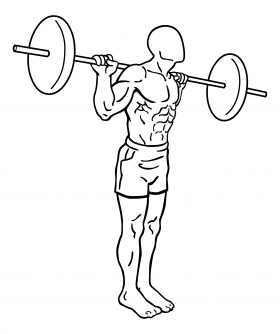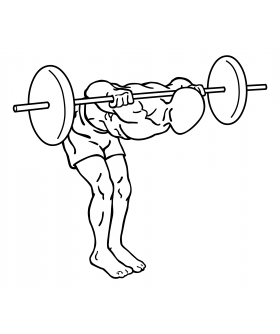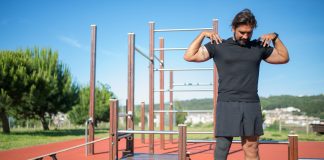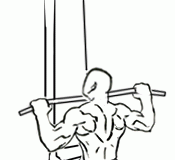Last Updated on September 25, 2014
This is one of the oldest exercises in bodybuilding but it still is one of the best for working the lower back. Some exercises come and go with fitness trends, but a select few remain constants because they simply work. One such exercise is the Barbell Good Mornings. It’s been around for decades and continues to be a staple in many workout routines, especially for those focusing on strengthening the lower back and posterior chain.
Despite its name, the Barbell Good Morning isn’t about greeting your muscles. It’s about engaging them in a powerful and effective way to improve overall strength, stability, and injury resistance. Let’s take a deep dive into this classic exercise, breaking down how it works, its benefits, how to perform it correctly, and some tips for incorporating it into your workout routine.
Why Are Barbell Good Mornings So Important?
When we talk about lower back strength, we often think about deadlifts, hyperextensions, or maybe even squats. These are all fantastic exercises, but the Barbell Good Morning specifically targets the erector spinae — the muscles that run along your spine — in a unique way. While it’s mainly used to strengthen the lower back, it also engages other muscles along the posterior chain, such as the hamstrings and glutes.
The posterior chain refers to the muscles along the backside of your body, which are crucial for movements like bending, lifting, and stabilizing. Neglecting this muscle group can lead to imbalances, which often result in injury or poor posture.
Incorporating Barbell Good Mornings into your routine can significantly boost your performance in other exercises, such as squats and deadlifts, by building a solid foundation of strength. Additionally, if you’re involved in activities that demand lower back and core stability (think running, lifting, or even just maintaining a good posture throughout the day), this exercise can be a game-changer.
Benefits of Barbell Good Mornings
Before jumping into the how-to, let’s look at why you should be including this exercise in your workout routine. Here are some of the key benefits:
- Lower Back Strength: The primary muscle group targeted by Barbell Good Mornings is the lower back. Strengthening this area helps support the spine, improves posture, and reduces the risk of injury, especially during heavy lifts or day-to-day activities.
- Improved Posterior Chain: Not only does it work the lower back, but it also activates the hamstrings, glutes, and calves. This full engagement of the posterior chain makes it an excellent exercise for overall body stability and strength.
- Core Stability: The movement requires a great deal of balance and control, engaging your core muscles to stabilize your torso. This can enhance core strength and improve stability in other lifts.
- Injury Prevention: By building a strong and resilient lower back, you reduce the risk of common injuries associated with weak or tight muscles, particularly in the lumbar region.
- Improved Hip Flexibility: As you bend at the waist during the exercise, your hips are also being stretched, improving flexibility and mobility over time.
- Enhanced Athletic Performance: If you participate in sports or activities that involve sprinting, jumping, or lifting, strong hamstrings and lower back muscles are essential. Good Mornings can help you develop the strength needed to perform better in these areas.
The Right Way to Perform Barbell Good Mornings
Although this exercise is highly effective, it can also be risky if performed incorrectly. The key to getting the most out of Barbell Good Mornings — and avoiding injury — is proper form.
Here’s a step-by-step guide on how to perform Barbell Good Mornings correctly:
Step 1: Setting Up the Barbell
- Begin by positioning yourself under a barbell, similar to how you would set up for a squat.
- Rest the barbell across the back of your shoulders. Make sure it’s not too high on your neck to avoid unnecessary strain.
- Grip the barbell with your hands slightly wider than shoulder-width apart. Your elbows should point slightly backward, and your chest should be lifted.
Step 2: Engage Your Core
- Before you begin the movement, engage your core by tightening your abdominal muscles. This is crucial for stabilizing your spine and preventing injury.
- Keep your chest up and maintain a neutral spine. It’s important that your back stays flat throughout the entire movement to avoid putting pressure on your lower back.
Step 3: Bend at the Hips
- With your core engaged and back straight, slowly bend at the waist.
- The movement should come primarily from your hips, not your back. Imagine you’re pushing your hips backward as if you’re trying to touch a wall behind you.
- Your legs should remain slightly bent (soft knees) to take some tension off your hamstrings and reduce stress on your lower back.
Step 4: Lower Until Your Torso Is Parallel
- Continue to bend forward until your torso is roughly parallel to the floor. You don’t have to go lower than this, as it may put excessive strain on your back.
- Keep your head up and look forward throughout the movement. This will help maintain proper alignment and prevent your spine from rounding.
Step 5: Return to Starting Position
- Once you’ve reached the bottom of the movement, use your hamstrings, glutes, and lower back muscles to slowly lift your torso back up to the starting position.
- Focus on keeping your core engaged and maintaining a neutral spine as you return upright.
Step 6: Repeat
- Perform the desired number of repetitions, usually between 8-12 for hypertrophy (muscle growth) or 4-6 if you’re focusing on strength.
Common Mistakes to Avoid
Like any exercise, the Barbell Good Morning requires attention to detail. Here are a few common mistakes people make when doing this movement and how to avoid them:
- Rounding the Back: This is perhaps the most dangerous mistake you can make when performing Good Mornings. Rounding your back puts excessive strain on your spine, increasing the risk of injury. Keep your chest up and back flat throughout the movement.
- Using Too Much Weight: It can be tempting to load up the barbell, but this exercise isn’t about lifting the heaviest weight possible. Start with a lighter weight and focus on maintaining proper form. You can increase the weight as you build strength over time.
- Bending the Knees Too Much: While a slight bend in the knees is recommended, bending them too much turns the exercise into a partial squat rather than a hip hinge movement. The goal is to stretch the hamstrings and work the lower back, so keep your knees only slightly bent.
- Not Engaging the Core: A weak or disengaged core can lead to poor form and increase your risk of injury. Before you begin the movement, brace your core by tightening your abdominal muscles and holding them throughout the exercise.
- Not Maintaining a Neutral Spine: It’s important to keep your spine in a neutral position throughout the movement. Avoid looking down or letting your head drop, as this can cause your spine to round and put unnecessary pressure on your lower back.
Variations of the Barbell Good Morning
Once you’ve mastered the basic form, you can try a few variations to challenge your muscles in new ways or to accommodate different fitness levels:
- Seated Barbell Good Mornings: Performing Good Mornings in a seated position places even more emphasis on your lower back by eliminating your legs from the movement. This variation is often used in powerlifting to build strength in the lower back and glutes.
- Banded Good Mornings: If you don’t have access to a barbell or prefer a lighter load, resistance bands can be a great alternative. The movement remains the same, but the tension from the band will provide resistance as you hinge forward and return to standing.
- Safety Bar Good Mornings: Using a safety squat bar (SSB) can take some pressure off your shoulders and neck while still allowing you to perform the movement. This is a good option for those who experience discomfort when using a standard barbell.
- Single-Leg Good Mornings: For a more advanced variation, try performing the Good Morning on one leg. This will not only increase the intensity on your hamstrings and glutes but will also test your balance and core stability.
How to Incorporate Barbell Good Mornings Into Your Routine
Now that you know how to perform Barbell Good Mornings correctly, the next step is figuring out how to integrate them into your workout routine. Here are a few ideas:
- As Part of a Lower Body Workout: Include Barbell Good Mornings in your leg day routine along with squats, deadlifts, and lunges. They make a great complement to other posterior chain exercises.
- As a Warm-Up: Performing Good Mornings with a lighter weight can be a fantastic way to warm up your lower back and hamstrings before moving on to heavier compound lifts like deadlifts or squats.
- As an Accessory Movement: If you’re a powerlifter or strength athlete, Good Mornings can be used as an accessory movement to strengthen your lower back and improve your performance in heavy lifts.
- Recovery and Injury Prevention: Even on days when you’re not lifting heavy, incorporating lighter Good Mornings into your routine can help maintain lower back strength and prevent injuries, especially for those who sit for long periods.
Conclusion
Barbell Good Mornings may not be as flashy as some other exercises, but they offer tremendous benefits, especially when it comes to building lower back strength and overall posterior chain stability. By performing them with proper form and gradually increasing the load, you’ll not only improve your lifts but also reduce the risk of injury and enhance your functional strength.
Whether you’re a seasoned lifter or just starting out, give Barbell Good Mornings a spot in your routine. Your lower back will thank you fo


Exercise images by Everkinetic.






